About worthy components and relevance of NWO
Hello GT! Today I want to touch on a very interesting topic on which I have received questions more than once. All of them are very different, but in a nutshell they are characterized approximately like this: “Why buy an expensive cooling system if it copes and is cheap.” I will try to answer the question "what is good SB capable of" under the cut.

Monsters from Noctua, Termalright and Phanteks were and remain the most "airs". Cost - from 70 to 100+ dollars, impressive size and impressive weight in the kit. These giants are able to make virtually any hardware silent, as well as provide amazing stability under overclocking and high load even on processors such as the Intel Core i7-5960X (8 cores, 16 threads, frequencies up to 4.5 GHz in good specimens under continuous load).

We will not talk about cooling 220-W heating elements (AMD 9590/9370, where you get out, let people watch and laugh), which are sold as processors by mistake. For the same money, you can take Core i5, which in performance in most tasks will bypass its hot rival, and pay only for the fact that AMD will have eight cores and almost five gigahertz ... well, you are all adults here, you understand. Back to the super towers.
Manufacturers of such cooling systems embark on all sorts of tricks, just to squeeze a little more out of the technology. They optimize the size and shape of the heat pipes, their distribution on the substrate, which is in contact with the processor thermal distributor, invent special sputtering to increase thermal conductivity, change the contours of the radiator plates to provide the most efficient airflow ... Well, of course, sometimes they simply increase the size. You just look at these giants:

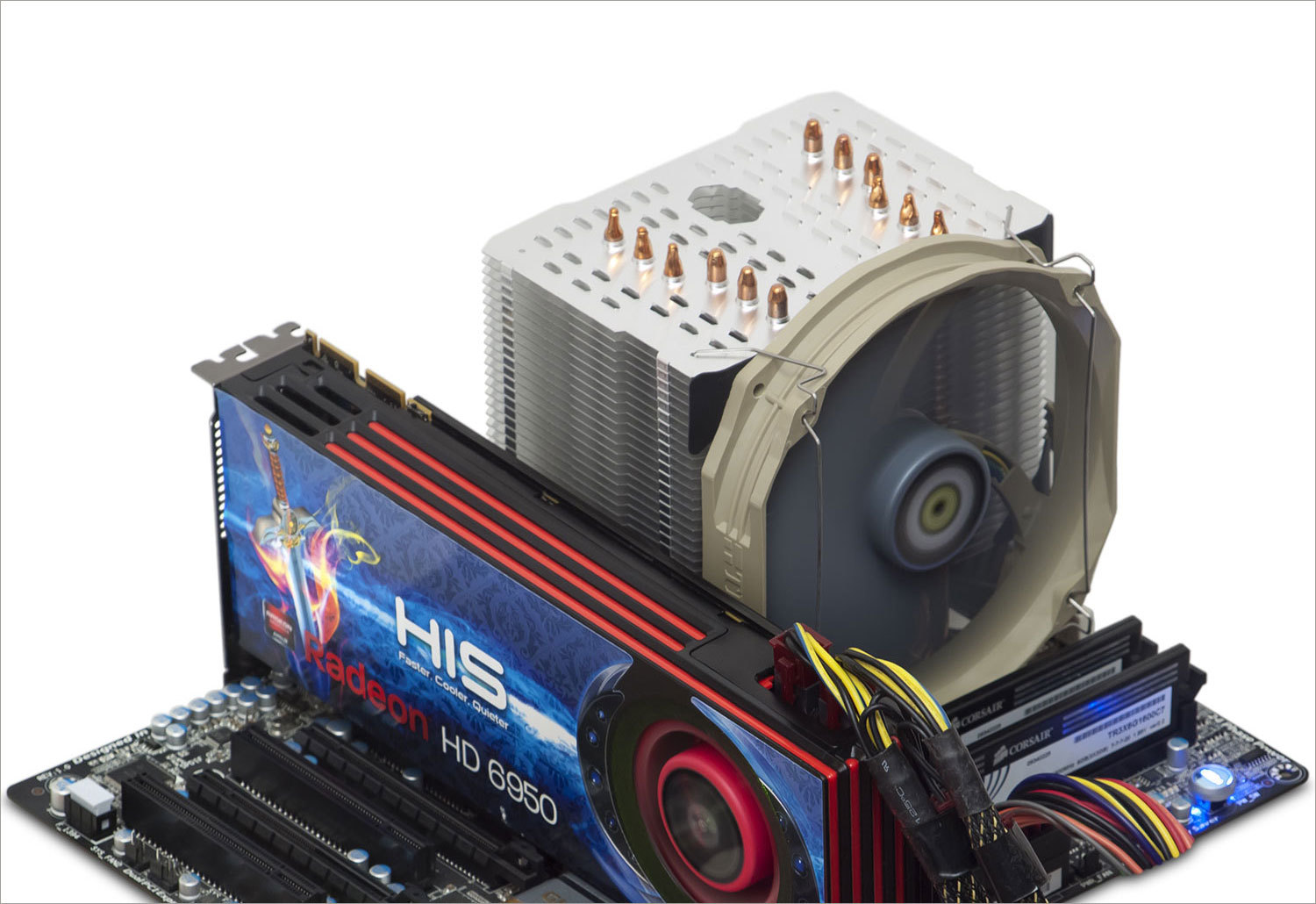

But what about processor manufacturers? Desktop lines every two years “reset” a couple of nanometers and increase frequencies, while heat packs for models with similar performance to previous generations are slowly decreasing, so only LGA-2011-3 processors and overclocked to 4.5 require active and very powerful cooling + GHz Core i5 and i7 k-series on 115x sockets.
In other cases (Core i5 / i7 without overclocking), there are more modest models: single-fan Noctua, Thermaltake, CoolerMaster.
Using water as a coolant is a good idea. It has been used successfully in steam locomotives and in nuclear reactors, so it will work here. Fortunately, the phase transition is not used as a method of heat absorption here, so the CBO is assembled quite simply. Moreover, for 5 years now, if not more, the so-called. "Factory dropsy", the complexity of the assembly and installation of which does not differ from the installation of supermassive air cooling systems.
The question is whether to use or not use the expansion tank - pure taste. There is nowhere to go in a closed factory system, in self-assembled ones it is more convenient to do as recommended by the manufacturer of the pump pumping the liquid.
The effectiveness of such systems as a whole depends on the same parameters as the “air”, just in this case the radiator that gives off heat is not located directly above the processor, but taken to another place: on the back or top wall of the PC. So to the full height the same questions arise here as the “classic” coolers: the dispersion area, the volume of air pumped per hour, the resistance of the radiator fins to the flow.
I want to note right away that when you set up a factory water cooling system (especially after the “super tower” or any other high-quality air cooling) you will not see -10 degrees in idle and -15 under load. The only difference between “dropsy” and “air” is the place of heat dissipation, plus a water-cooled system will take some time to “warm up” the entire volume of water from the pump to the radiator ~ to the temperature of the processor cover. After removing the load from the processor, in the same way, the temperature will be higher for several minutes than with an air cooler similar in dissipated power, simply due to the fact that the coolant is more inert than the evaporative heat pipe system and metal radiator.
I see several reasons for using factory CWOs: the desire to get stuck, the desire to assemble a powerful but very compact computer, and the desire to assemble a powerful AND very quiet / silent computer.
In the first case, I will not dissuade anyone. Any whims for your money. In the second, often, dropsy is the only way to cram the unedited. In the third, everything is complicated. It will not work to assemble fully passive cooling on powerful components; custom NWO and a water block on the video card are an option, but will require at least minimally working fans, blowing a powerful radiator. And you can simply assemble an “inaudible computer day and night” in the air. I don’t know how it is with you, but the power supply unit is the most noiseless for me now.
What will happen if you don’t look into the computer from the moment of its assembly? My PC based on i7-3930K was assembled at the very beginning of 2012, and since then the only thing I did in it was testing video cards / RAM. The rest of the glands, as a rule, were tested on a demo stand from another iron, which you do not need to climb into: put, tested, removed.
All this time, the legendary Noctua NH-D14 was engaged in cooling the processor. Outwardly, everything was always in order with her, a couple of times he wiped the dust from the external impeller. I didn’t even look into the basket with screws that stood behind the 180 mm fan, and the screws in it stood even longer: some years since 2011, when everything moved into this case with the Core i7-2600k.
During all this time, temperature monitoring did not reveal anything unusual. Well, the time has come to find out how many different things the cooler managed to pump, and how much this affected the atmosphere inside the case. \
Temperature without load and after half an hour of high-quality multi-threaded load.

As you can see, the results are very far from critical ( according to Intel Ark ) for the i7-3930K 67 degrees. Start raking the Augean stables? :)
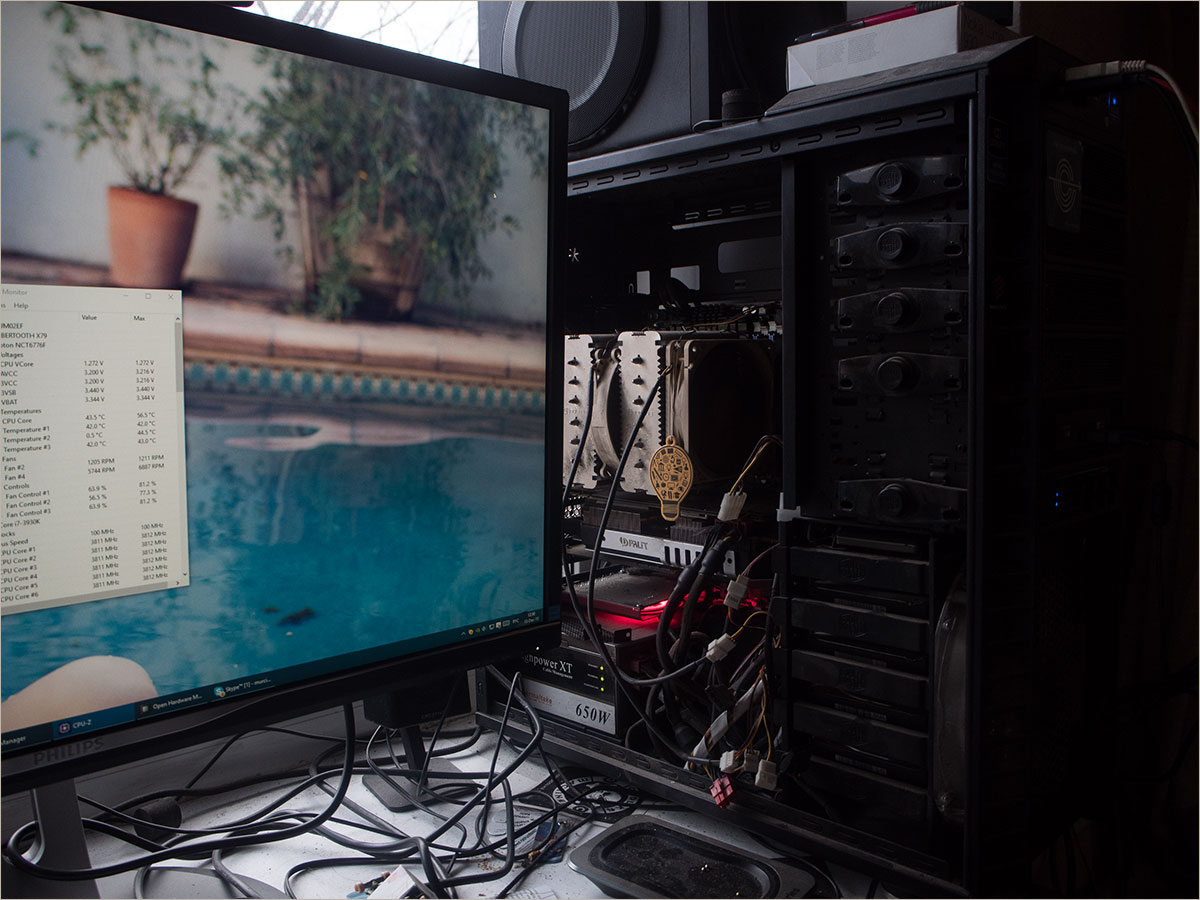
At first glance, everything is fine. Well, a little dusty, it happens. Otherwise, everything worked perfectly, the temperatures you saw above on the screenshots. The side covers were closed, on the intake fans there were thick foam filters that were regularly cleaned. True, the computer stood next to the balcony door, which had been open for half a year.
Here, by the way, is the first serious minus of the "old" power supply. No, he is not bad, and still works like a clock (and he, for a moment, is 7 or 8 years old for sure, if not more). But thick cables with an extra braid were barely able to be placed between the backplate and the back cover.
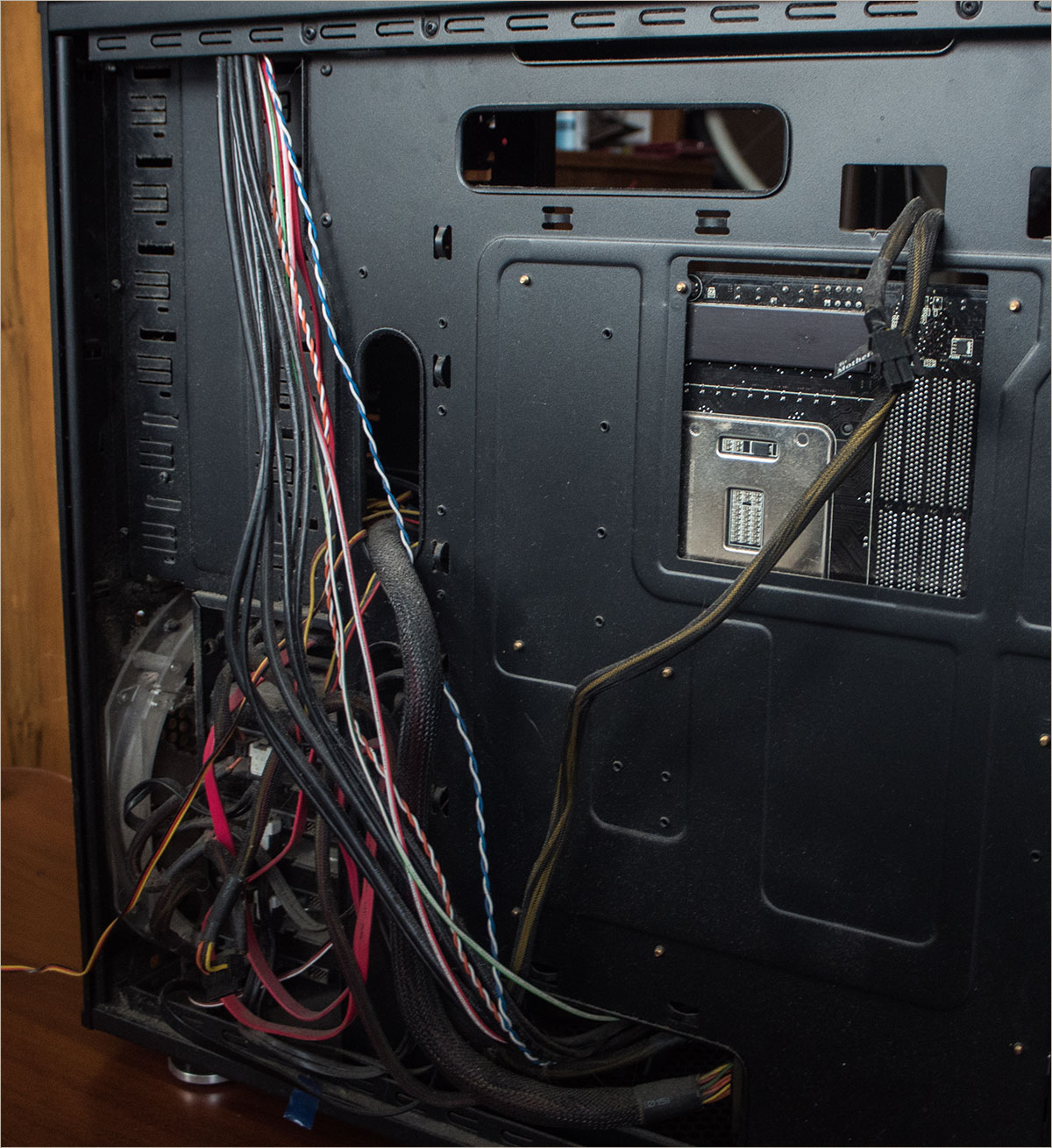
Here's what happens if you hit the grille from below:
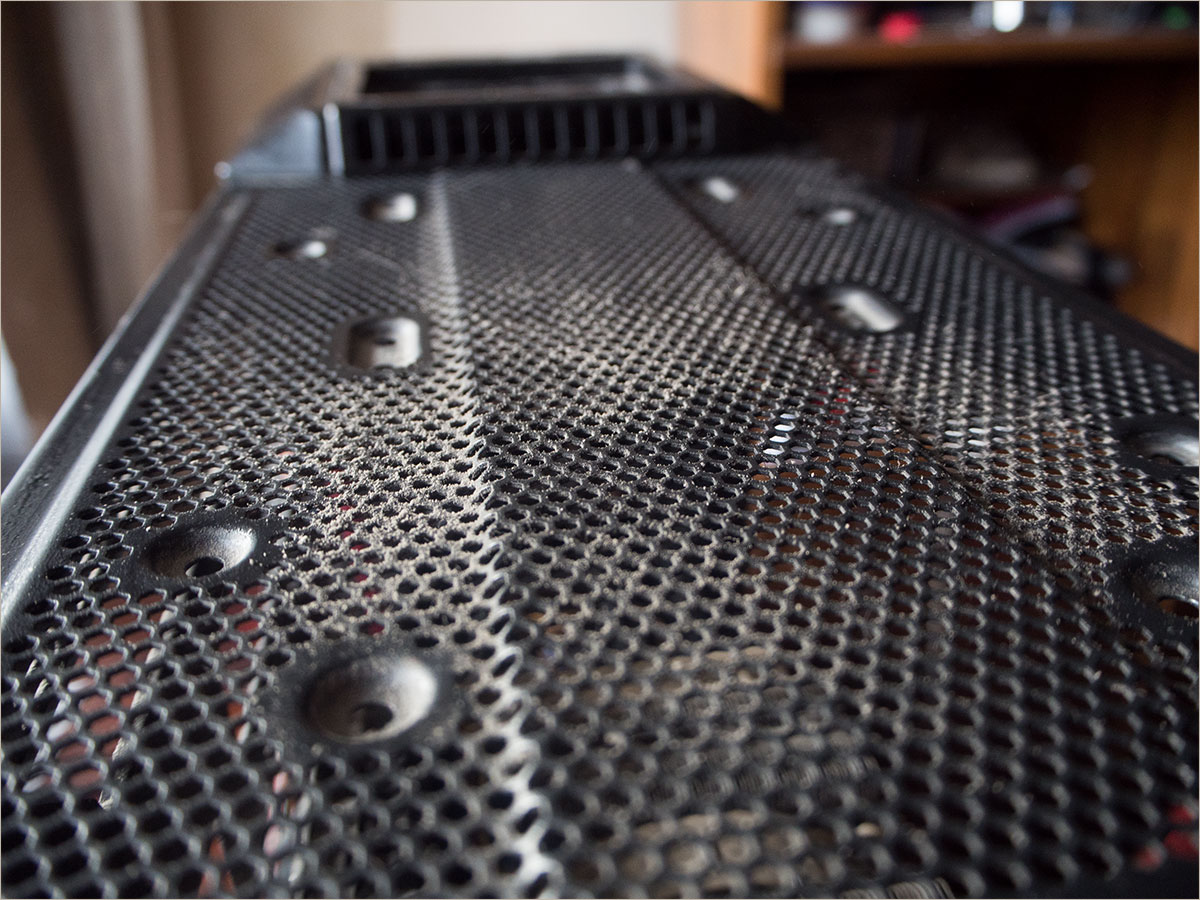
Instead, NH-D14 will be the factory dropsy DeepCool Captain 360 . Why 360? Because 3 sections for 120 mm coolers. There are also Captain 240 (the price is almost the same) and Captain 120 (significantly cheaper), two and three times shorter, respectively. The radiator is so long that its last part will go beyond the perforated zone and will be in the region of the first slot for an optical drive. Fortunately, the developers of the case (Cooler Master HAF-932, another "legendary" piece of iron, its ideological successor - HAF X ) also provided such huge radiators, so there will be no problems with the mount.
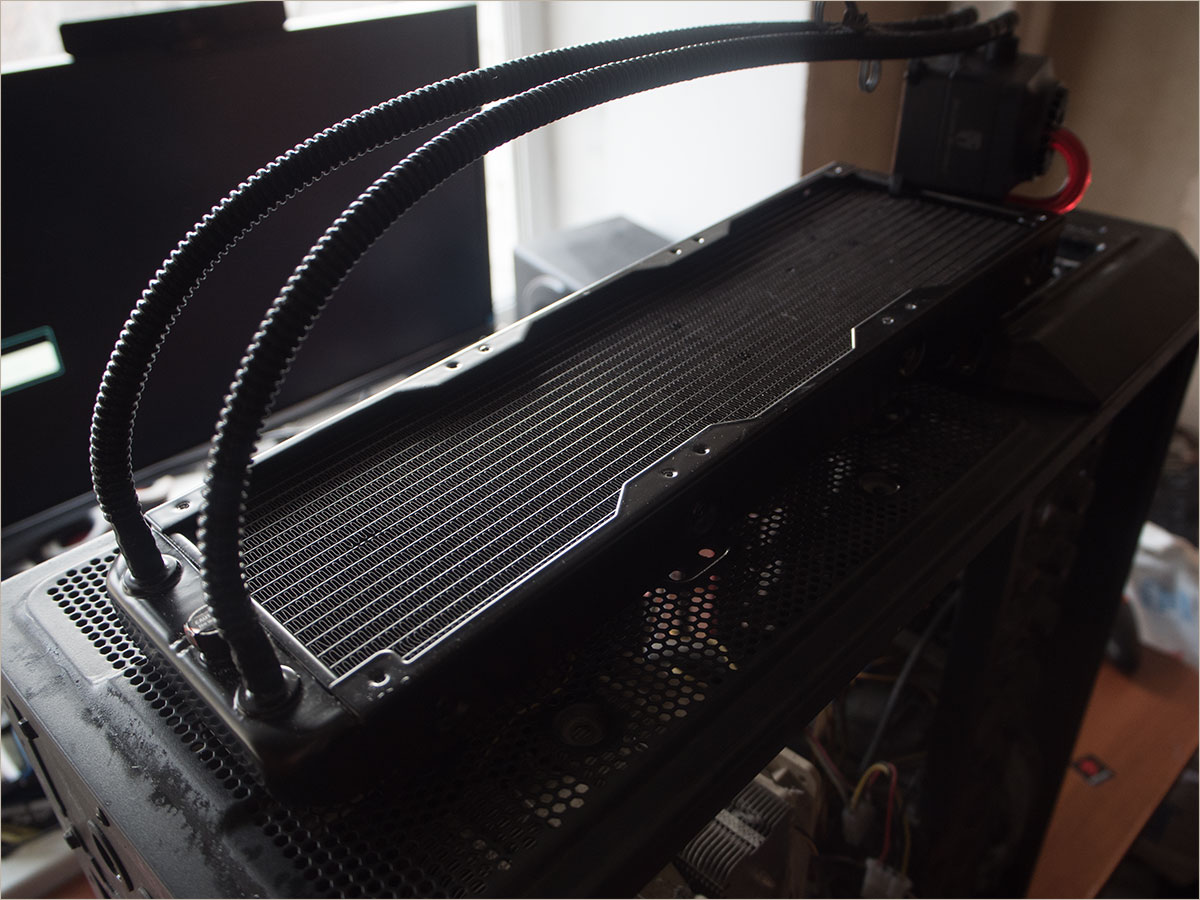
Thermal grease is applied with such a "factory" pattern. Grease - my jamb, inaccurately opened the protective plastic cover, and it fell to the base. In fact, the application area is slightly larger than the thermal distributor of the processor, so there will be no problems.

Another plus in the piggy bank of the creators of the body. PSU can be placed both below and above. Moreover, there are provided conclusions for “custom” water and hoses.
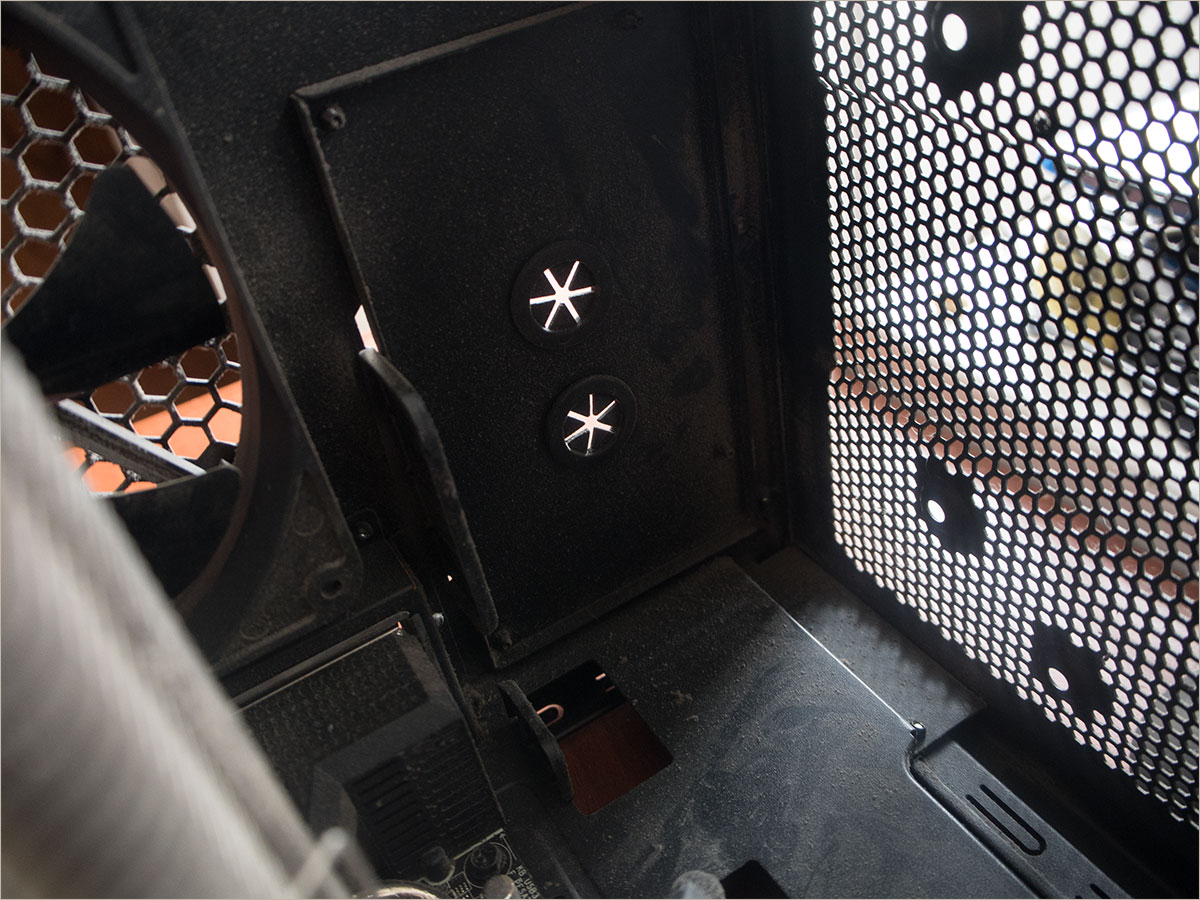
In my case, the PSU is at the bottom. This creates some difficulties (the cables are not designed for such an installation), but there were reasons for that: I used to have a CBO on the I7-2600K.
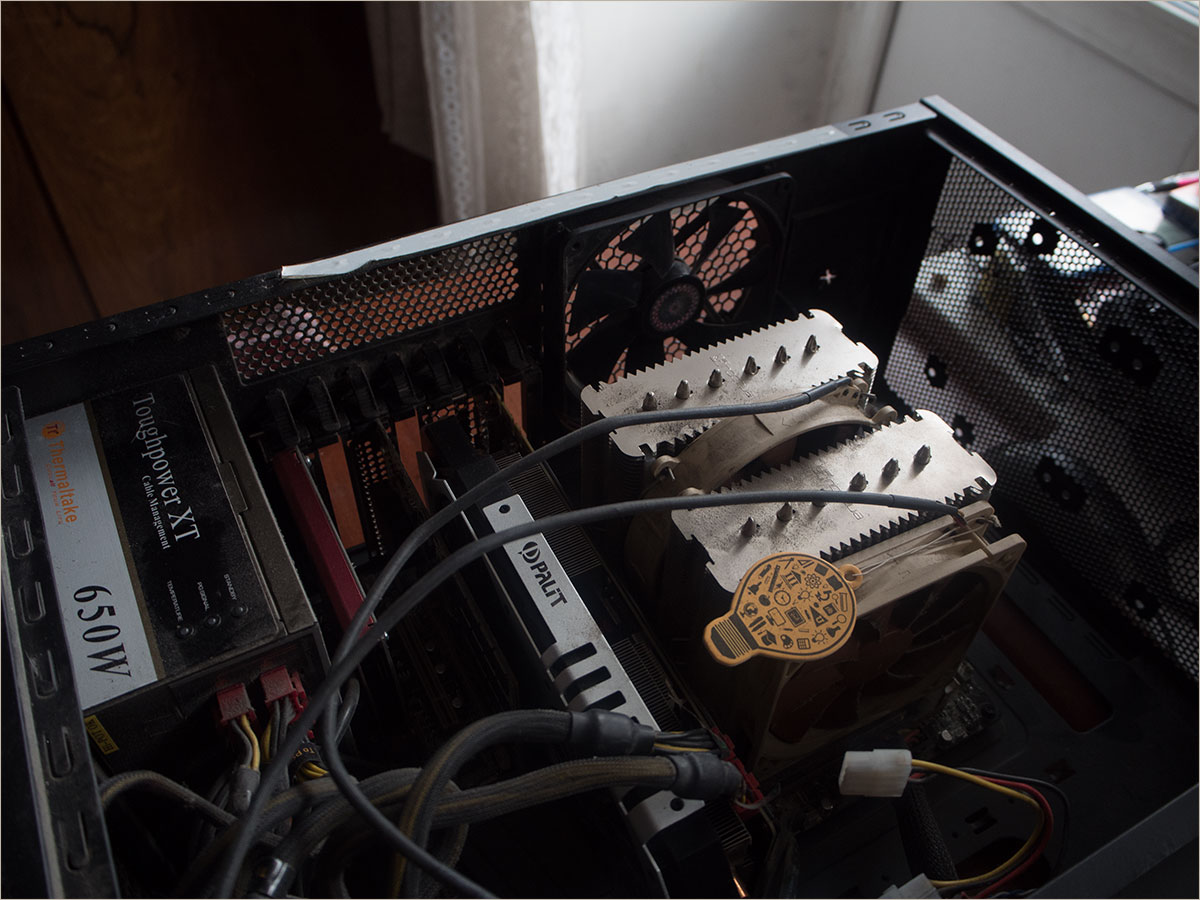
We remove the fans, which instantly hook with themselves a piece of "felt boots" formed on the radiator.

I would also like to note a special “serrated” edge of the platinum: it is made to reduce the noise generated by the air passing through the radiators. However, she also collected dust perfectly all these long nearly 4 years.

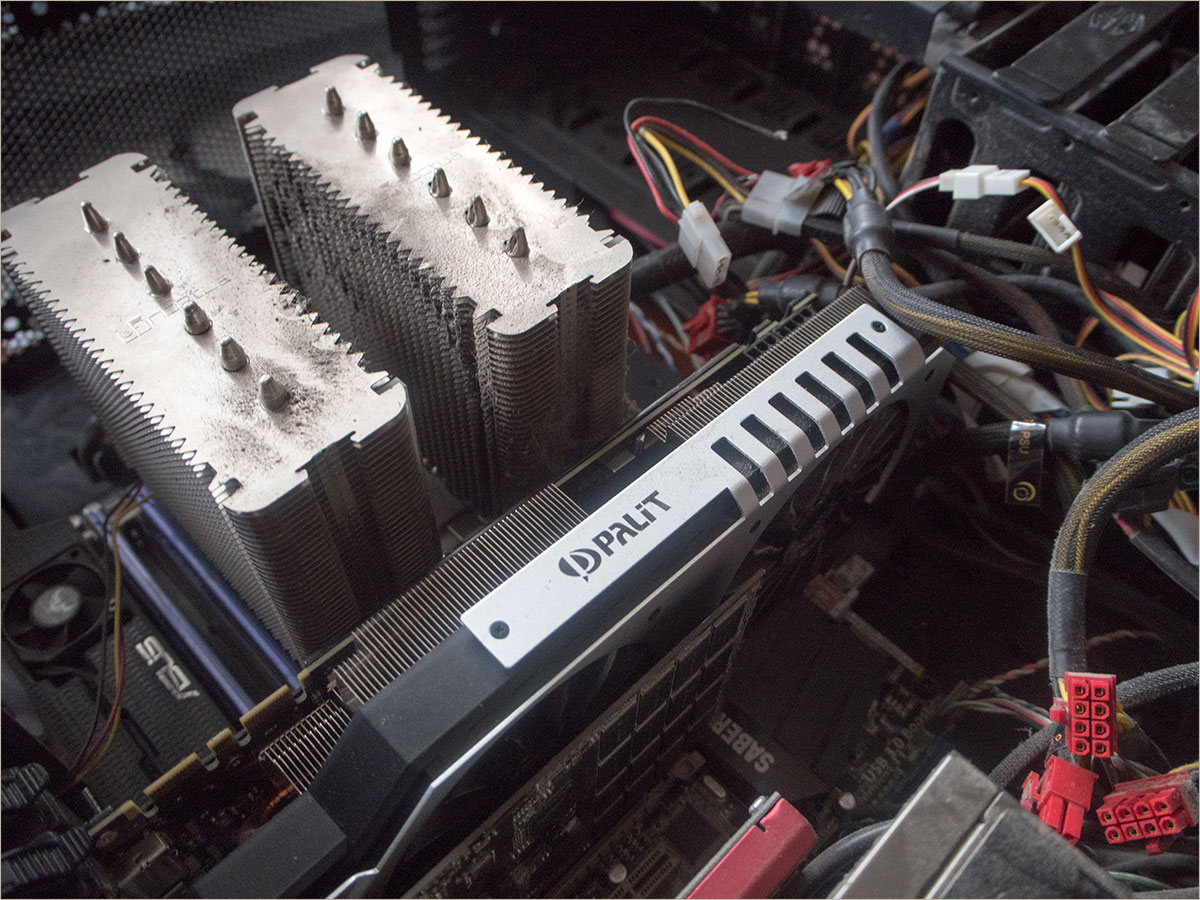
The charms of the Palit's cooling system and the generally non-hot temper of the 980Ti: 90% of the time the fans either stand still or spin at a minimum speed. As a result, for half a year there is no dust at all in the video card. Only on the edge of the impellers are few.
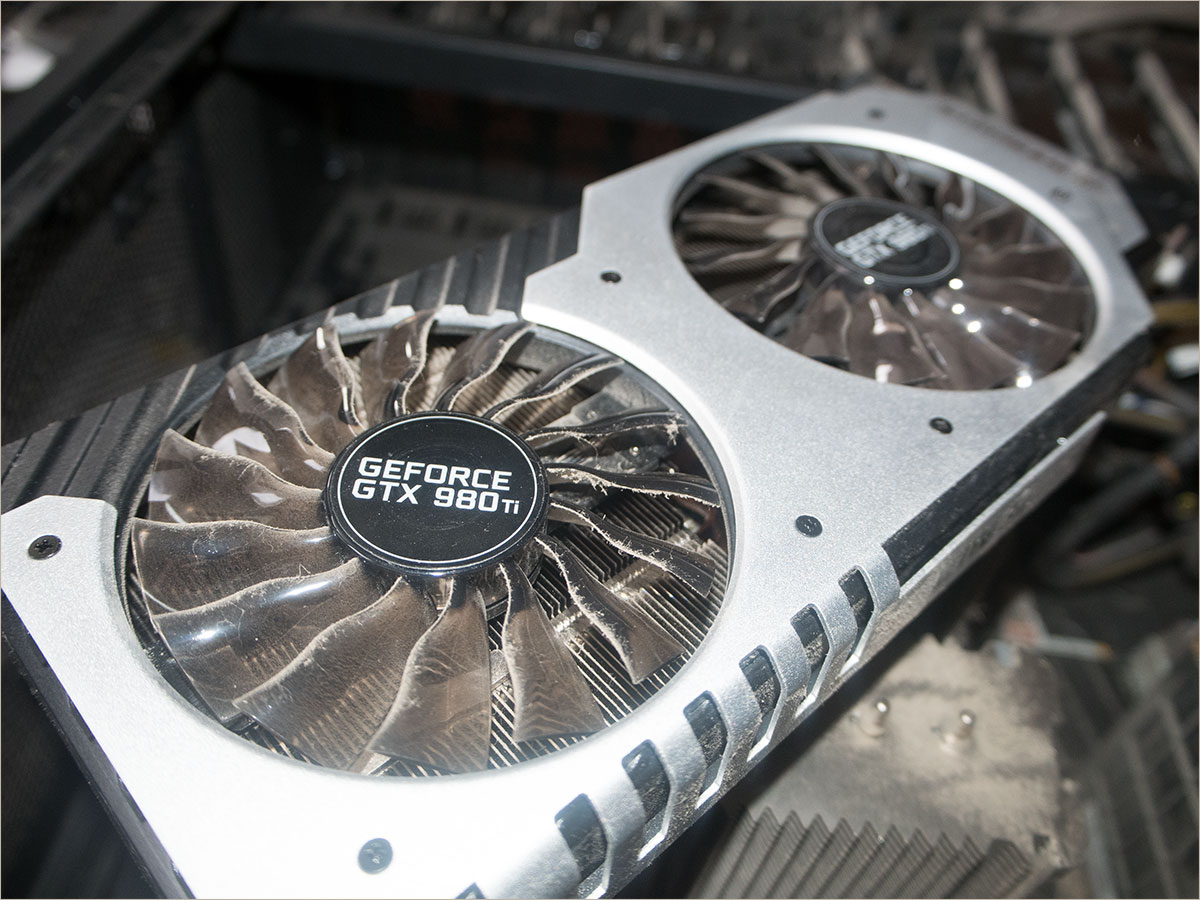
We shoot sound and SSD-drive. I don’t know how to remove the dust that accumulated inside this beautiful red thing. Unless try to blow with compressed air.

Mda Little is beautiful:

For which we love Noctua: in the kit there is always everything you need for installation. Even a very long screwdriver.
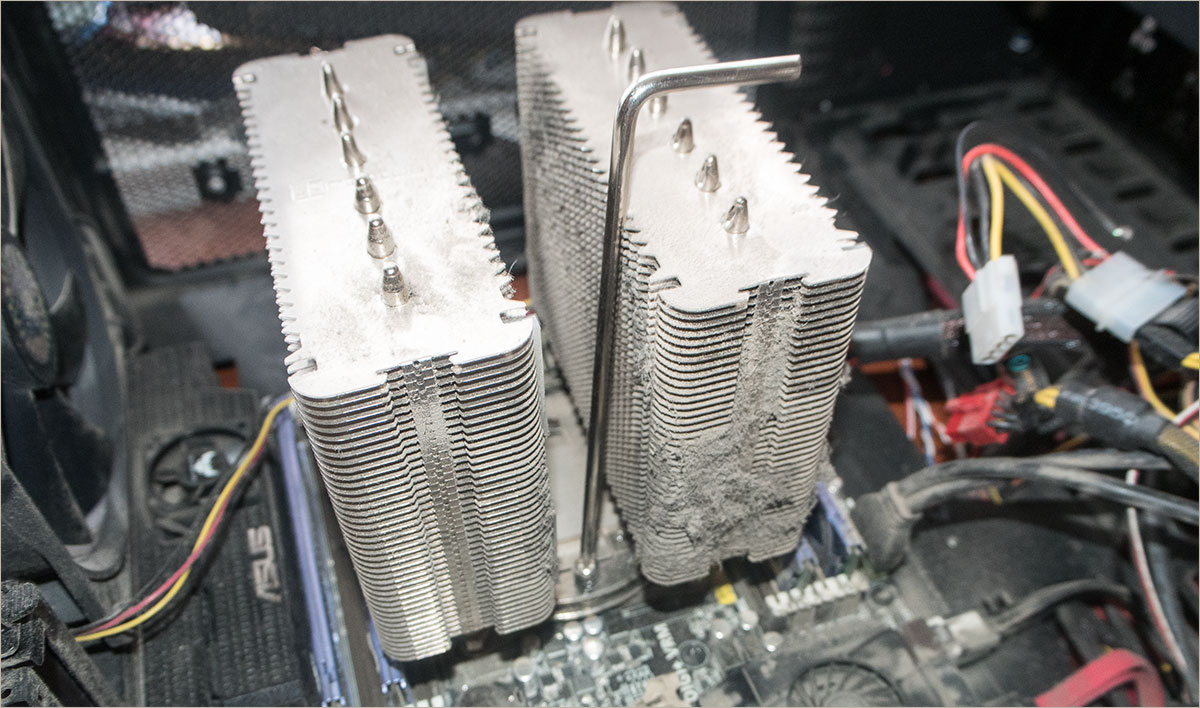
Noctua's native thermal grease is still alive, lubricating as easily as on the day of application! Recommend!
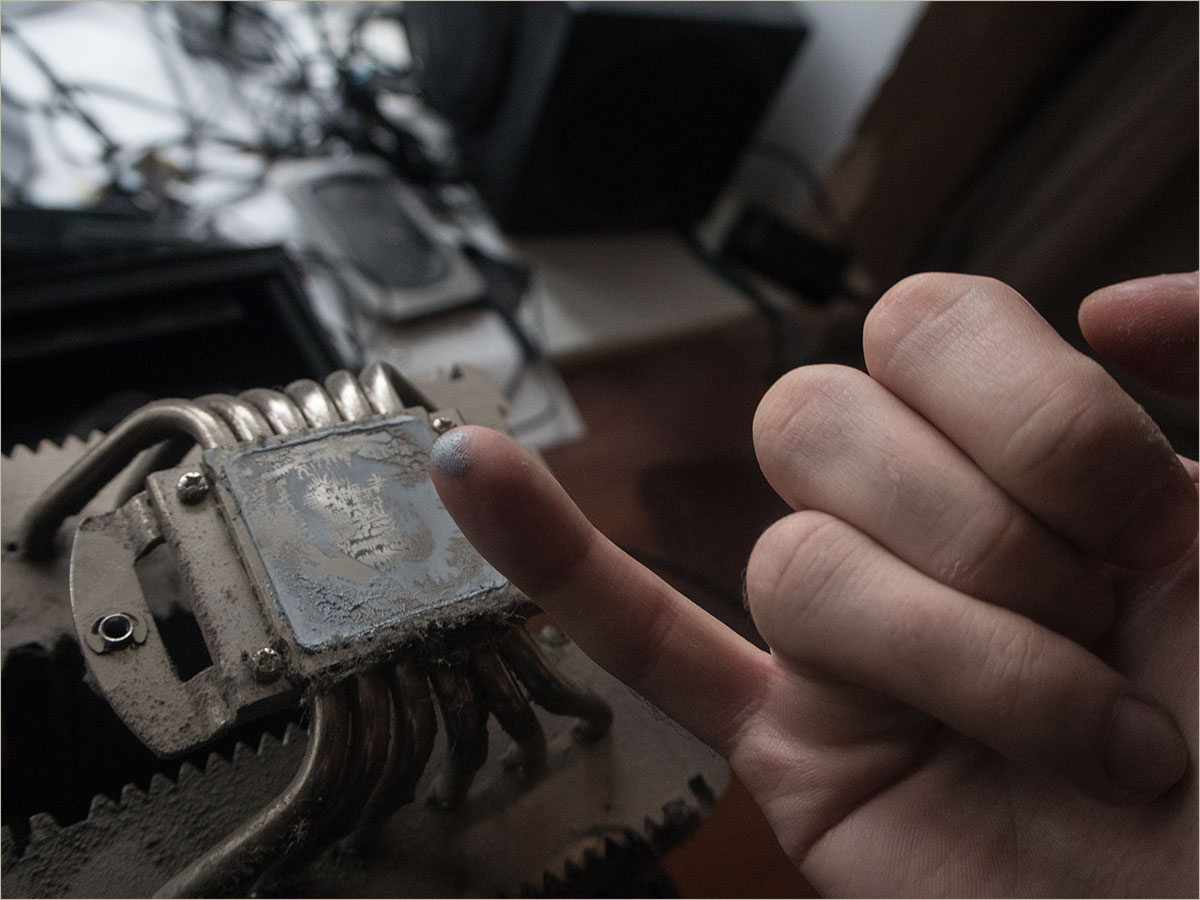
30+ thousand hours of blowing fans.

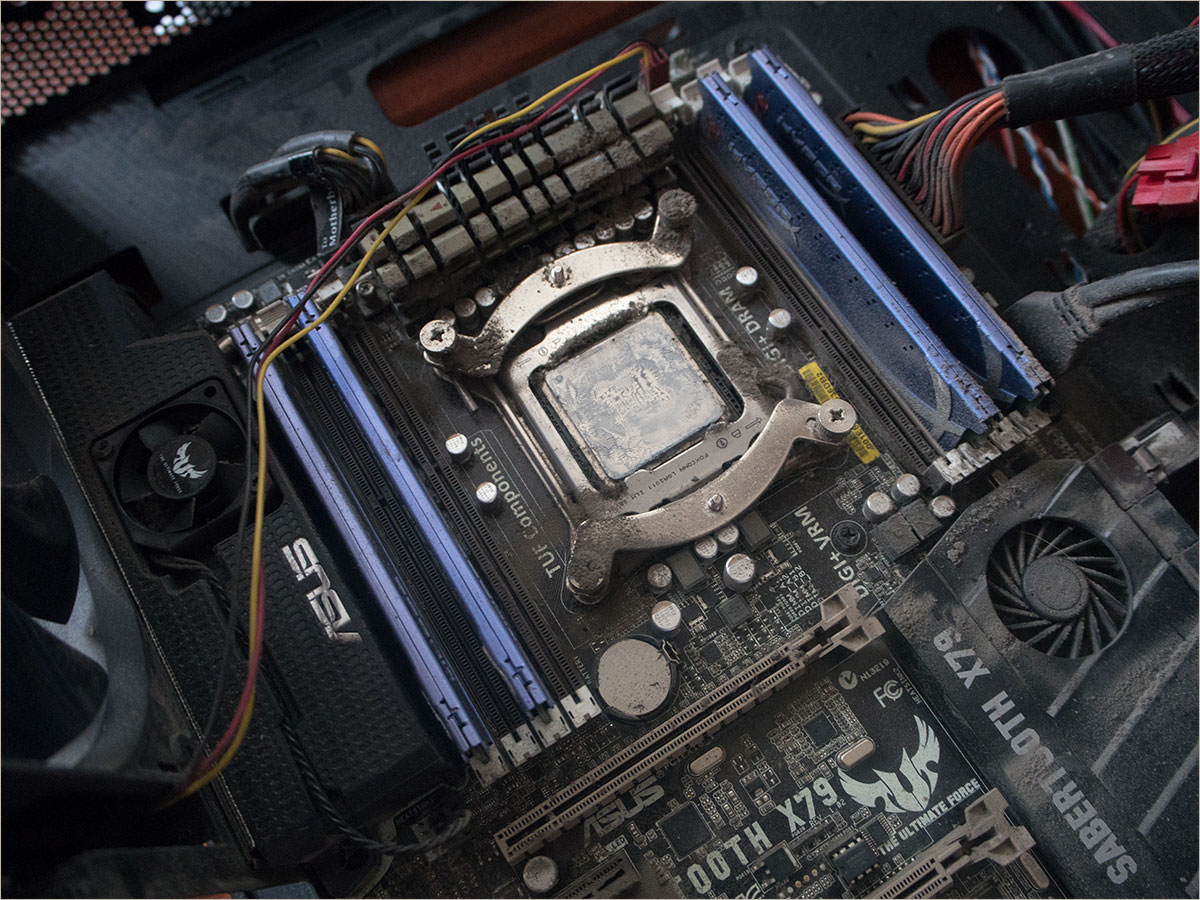
The thermal paste print is nowhere fresh. Dust sticks only in the way:
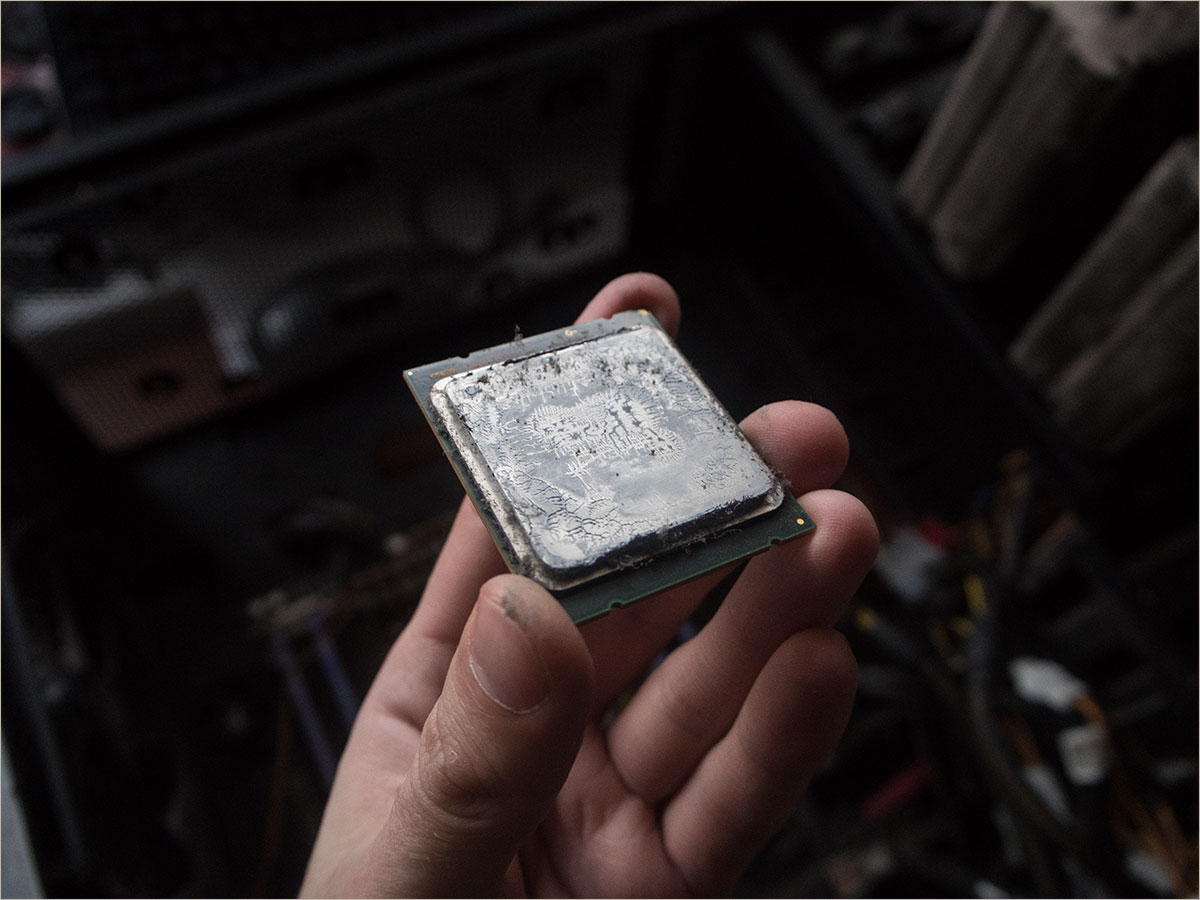
Fu:
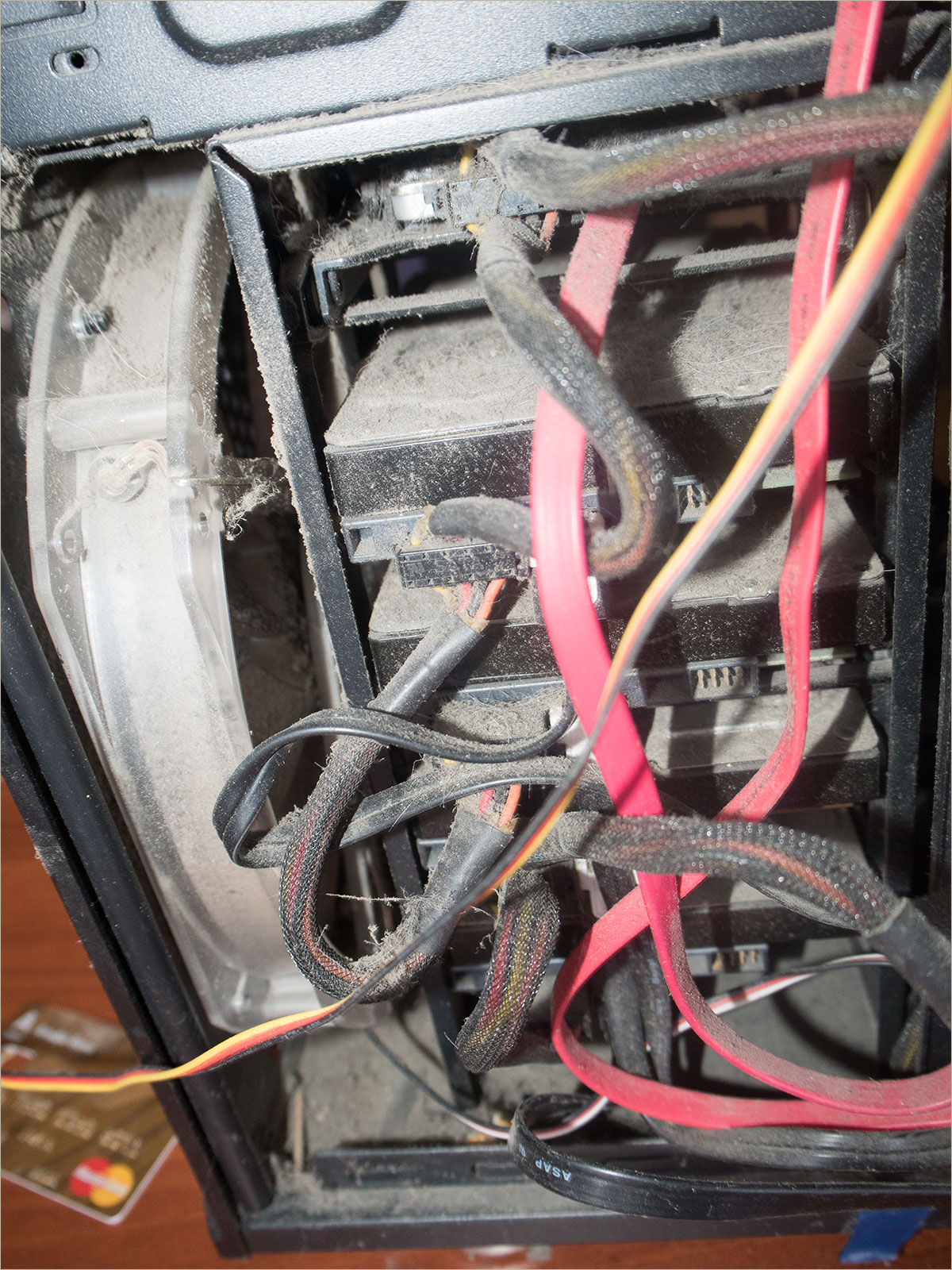
By the way, what I was talking about. Inadequacy of loops. Their connectors are installed in such a way that the loop can only be thrown from top to bottom. Well, or you can try to screw the screws upside down. :)
But here's a little strange: a transparent plate is installed behind the vane power supply, which cuts off a good 40% of the air flow. What for? The riddle.

There is no such garbage in this:
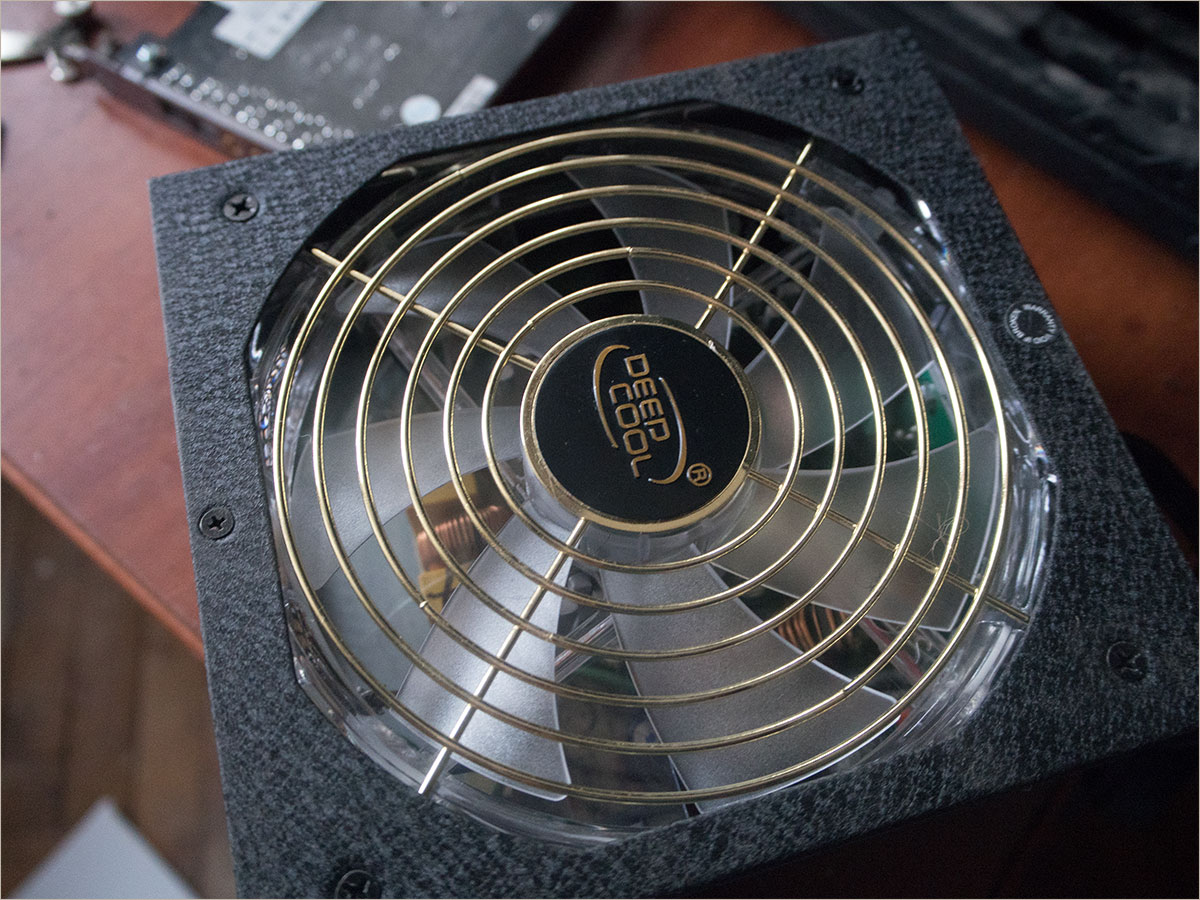
There was a power supply. You can even write a finger about it. :)

The processor is simply wiped with a cloth. Everything came literally in 1 second.
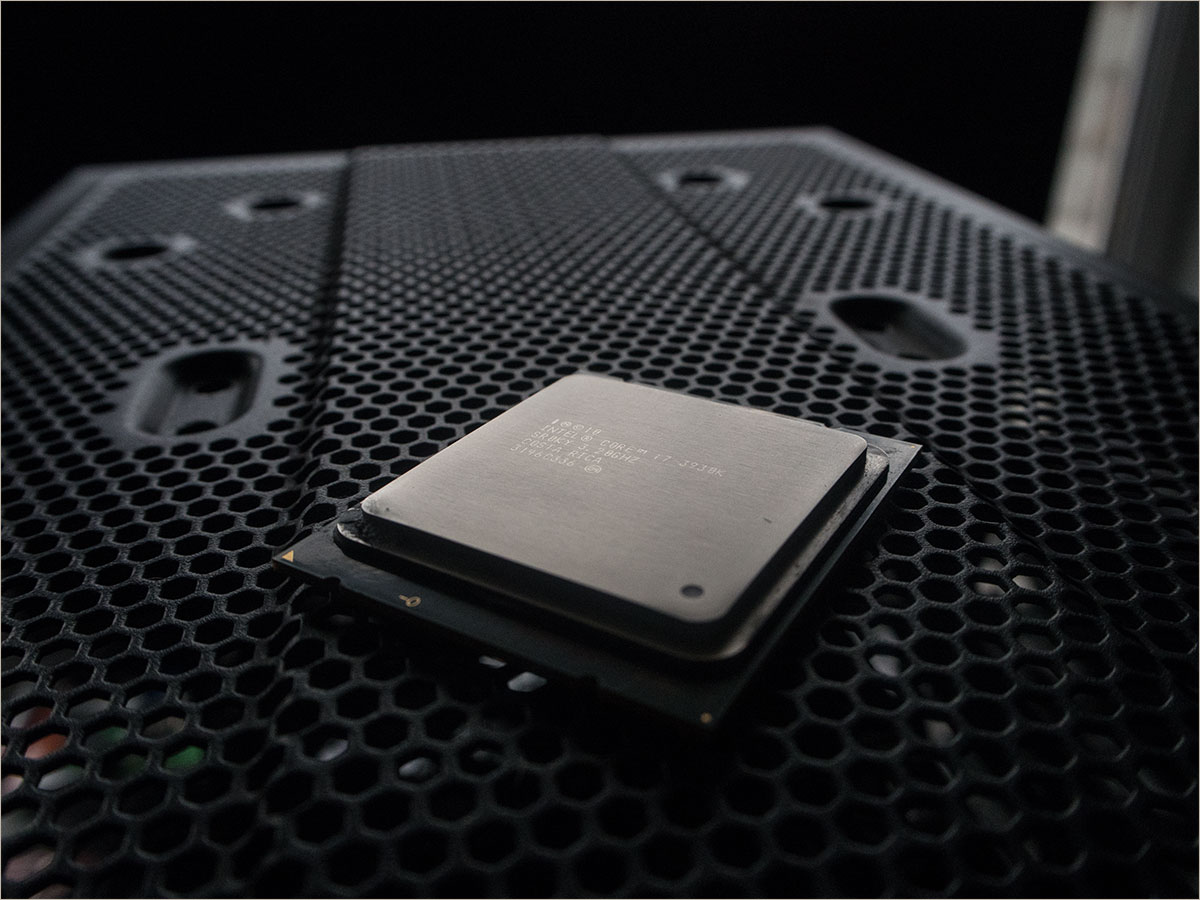
He cleaned out all the dust, wiped the case, threw away the garbage, washed the fans, it was time to collect the water cooler. Her instruction, to put it mildly ... Primitive. One such leaf here:
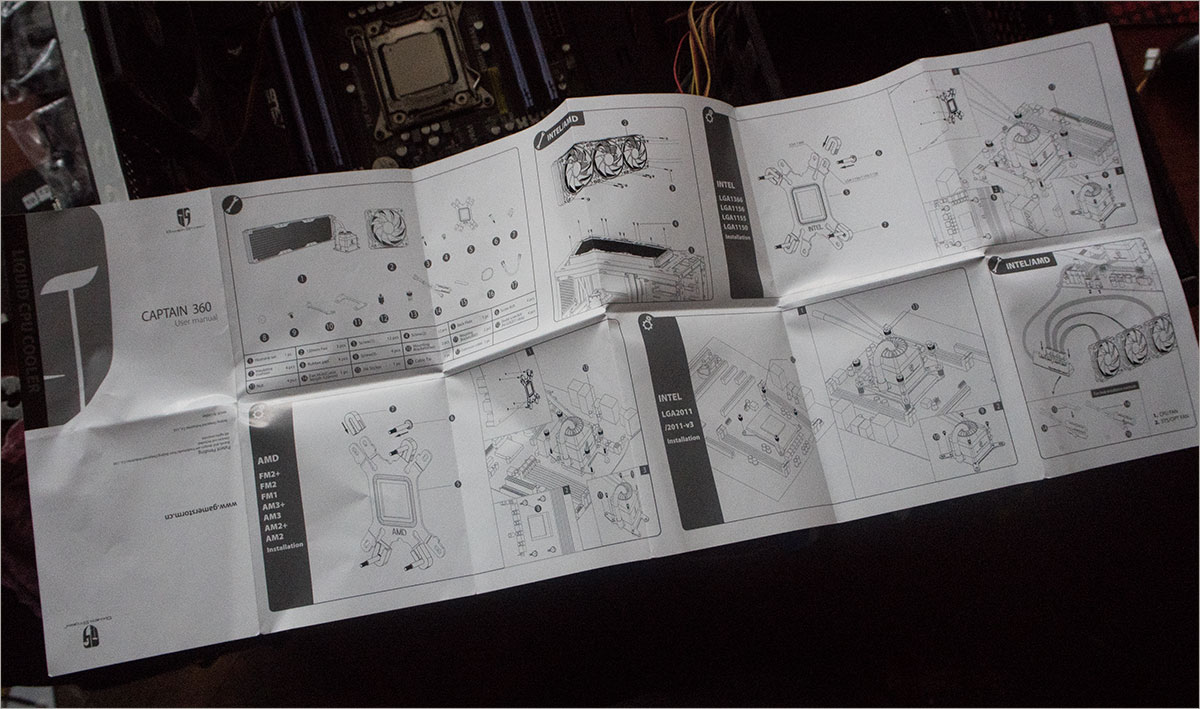
Regular fans have frames from ... I would call it hard grades of rubber. In fact, most likely, this is just flexible plastic, albeit a "rubber" touch. Vibration absorbs perfectly.
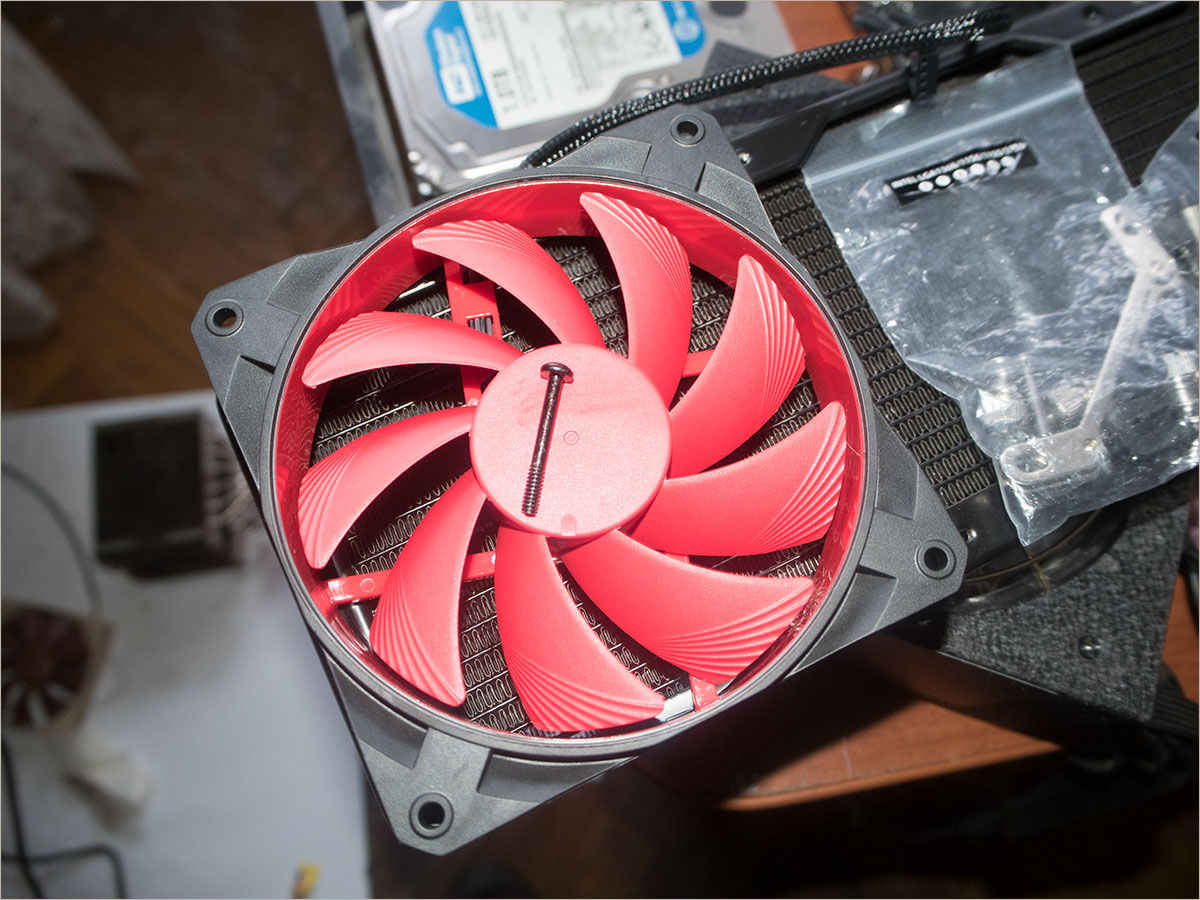
In the photo there is a package with mounts for the socket 2011 of the first revision of these dropsy. The mounts are frankly terrible, but along with dropsy I got another set of mounts, completely different in terms of quality and ease of installation. That is, while this CBO was reaching us, the developer managed to fix the marriage and also finish the jamb fix sets for retailers. Nicely.
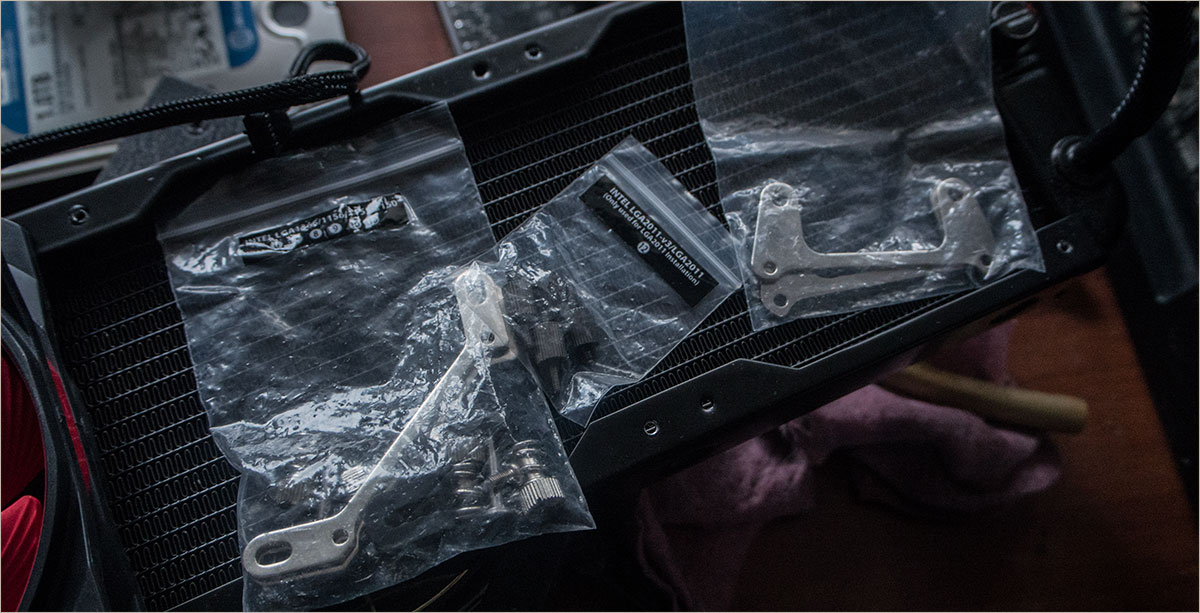
The weight 2.0 mounts have already been used here:

As you can see, the radiator goes into the basket of optical drives, but this does not interfere with the installation and blowing. The new power supply has flat cables; there is no problem with placing them at the back. The pump itself is powered by a standard fan connector on the motherboard. Some competitors take power from internal connectors for USB connectors.

A trio of fans connects to the system board through such an adapter. To be honest, I'm not very happy with this decision: I'm not sure that the motherboard manufacturers were counting on connecting three loads to one place. Such currents can kill both the connector and the paths leading to it. I would be calmer if only the instructions from the motherboard for the desired speed were taken from this bus, and the power was supplied separately, from USB ports or a SATA / IDE cable.
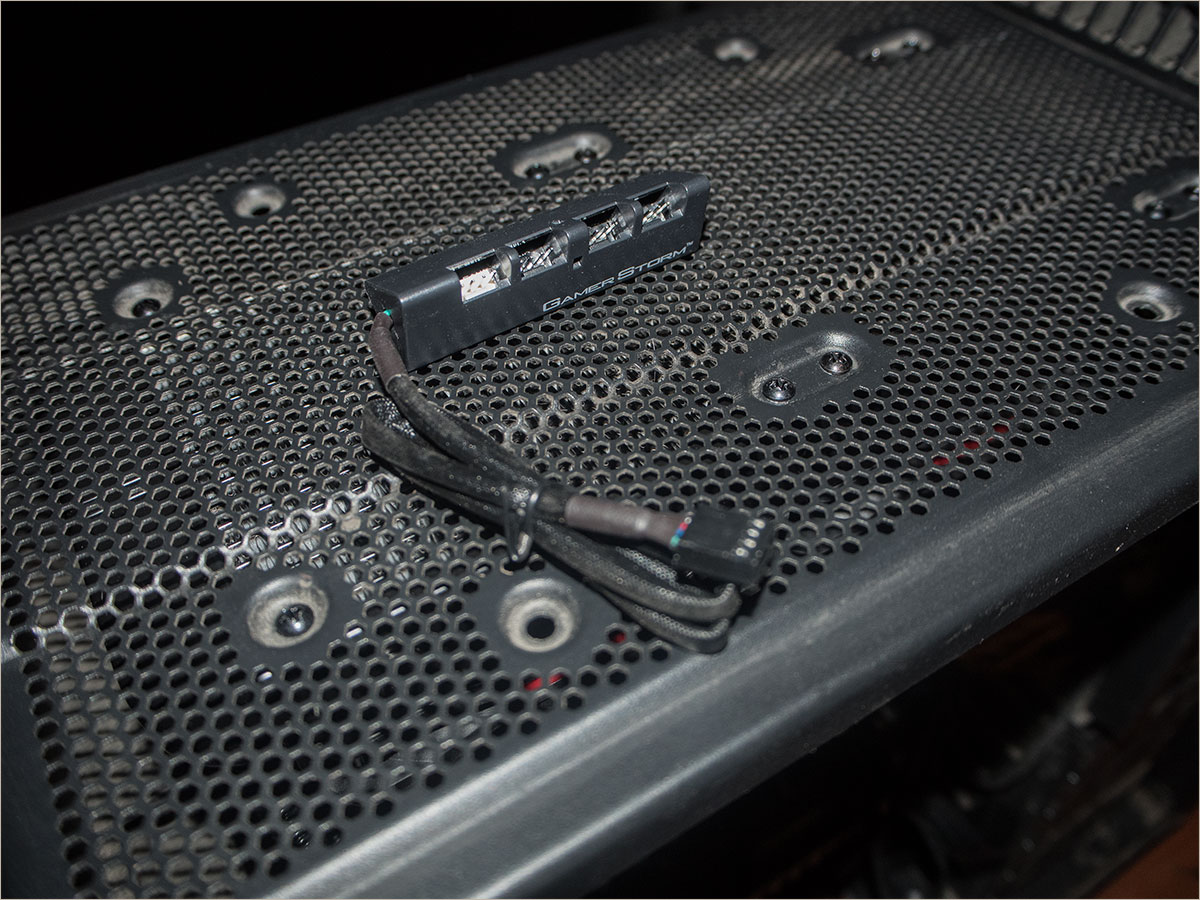
The white connector, apparently, is designed to install more and power the pump. A strange decision, then I will finalize with a file. ^ _ ^
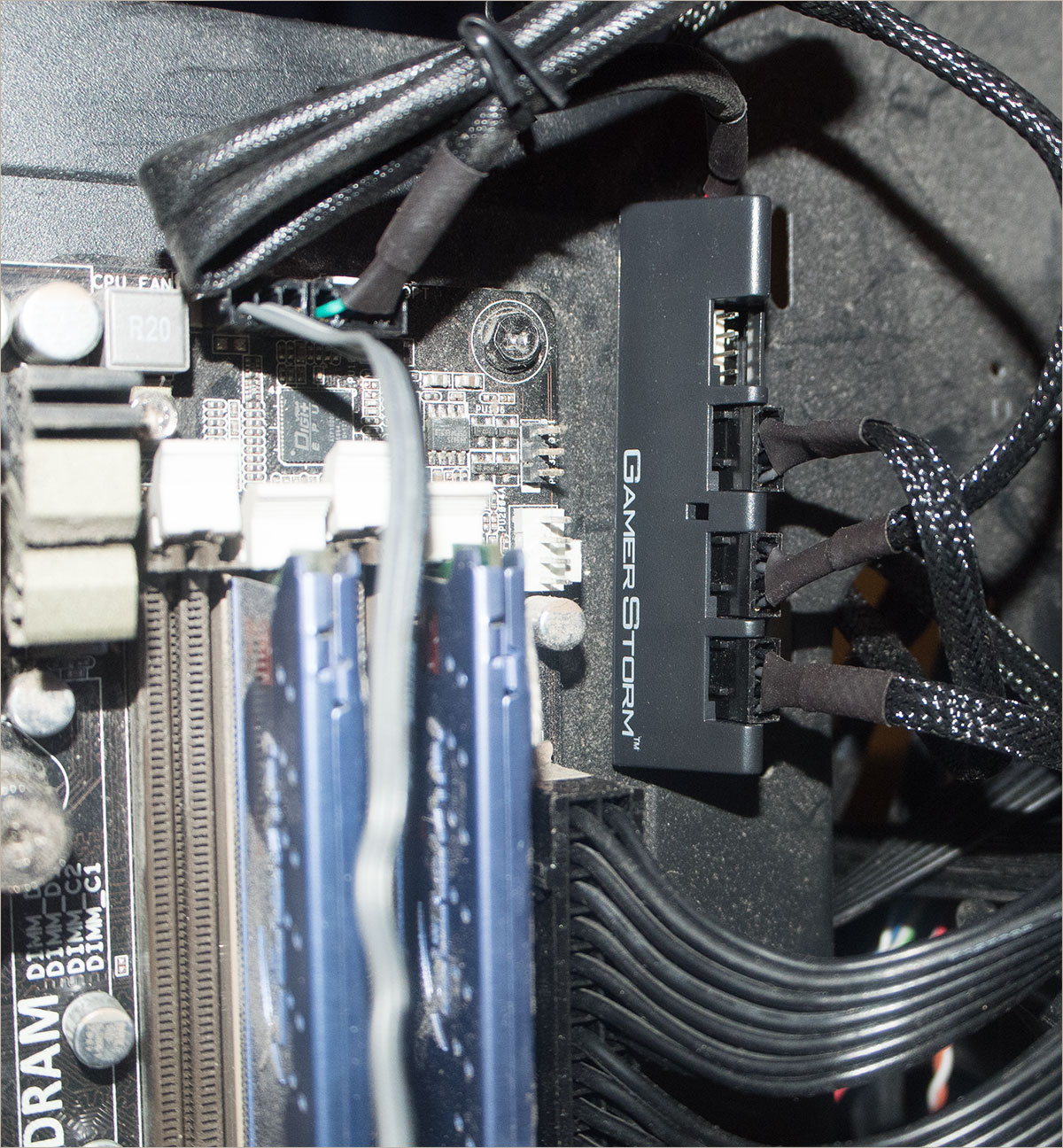
Everything is assembled and with a backlight. You can close the lid, it’s time for tests. In the BIOS, remove the PWM for the pump, set the SILENT profile for the fans, set the minimum speed to 400. After a few minutes, the system becomes completely silent (which was the case with Noctua NH-D14), only the power supply fan is heard. Bubbles of air from the cooling circuit came out quickly, however, I did not shake actively and did not turn the system over. There were complaints on the network about the noisy operation of the pump, my copy does not suffer from this.

In idle time, after the system temperature has settled down, the picture is somewhat worse than with the NH-D14 tightly clogged. Two hours of heating did not allow the system to warm up higher than 56.5 degrees, that is, under load, the effect is the same as that of the super tower, which collected dust for more than three years.

Here the casing made its corrections to the measurement: the well-blown BigTower with plenty of free space and extremely perforated on all sides.
Even the AIDA-64 stress test failed to warm the processor above the throttling temperature:
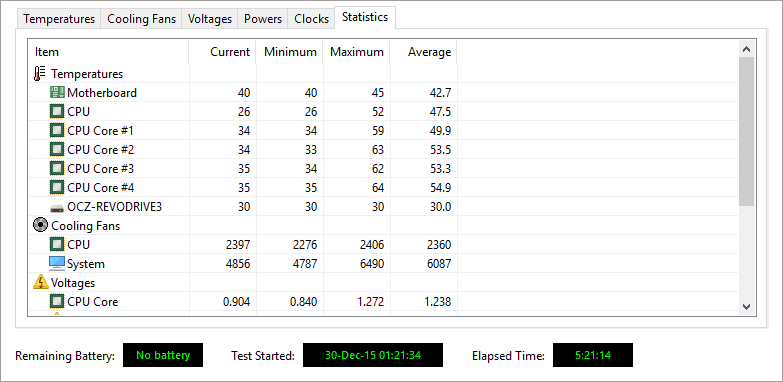
With the cooling of even such an "evil" processor as the six-core i7-3930K, the system coped with dignity. At the end of the test, the fan speed rose slightly, but in general the acoustic picture remained more than comfortable. But if the difference with the “super-towers” (and the NH-D14 is by far not the coolest super-cooler) is not so great, why then do we need maintenance-free air-conditioning systems? The answer is simple: for tight cases and tricky assemblies.
Such a “two-section” (Captain 240) allows you to build a very powerful PC based on the top consumer i7 with MiniATX-board in an ultra-compact package (especially if you use the relatively cold GTX 970/980 / 980Ti, which passive or semi-passive cooling most of the time). The only condition is to use high-quality cases, which provide for the normal location of the water cooling system and blowing hot air out of the case - the Corsair Carbide 240 Air or TT Core V21 are perfect. Yes, if desired, something classic can be crammed into them, but here the question of the competent organization of air flows will arise in full growth.
If you are not a fan of overclocking, use conventional processors (from Pentium G3250 to Core i5 / i7 without the “K” index at the end) and don’t want to spend a lot of money on cooling - take the Cooler Master Hyper 212 Evo . Proven solution. Quiet, reliable, widespread, inexpensive and not the largest cooler.
In small-sized cases (well, suddenly you are going in an ITX-format based on i7, which you will not find any perversions today), the Noctua NH-C12P SE14 will be an almost ideal option . Of course, the height and amount of free space should be compared in advance, not all buildings are equally well designed. An alternative for Noctua is the Thermalright AXP200 .
With the K-series of modern i7 and i5 they can even cope with hard overclockingNoctua NH-U12S , NH-U14S , well, and in compact cases factory two-section CBO will come to the rescue.
Super towers and similar three-section monster-CBO are relevant only in the case of a very hot climate or the use of high-end processors, such as the eight-core i7-5960X . Well, or if you misunderstood the AMD 9590 . According toeyewitnesses to the victims and survivors, HN-D14 and its tribesmen more or less cope. Installing such coolers in compact cases is another problem, and the high price of such cooling and the corresponding case will clearly not stop a person who paid between 600 and 1200 dollars for a single processor.
PS:Look at the computer more often, even if everything is normal according to temperature sensors and the general state of health of the iron. Nothing good from such an amount of dust, as I have accumulated, is definitely not worth the wait.
PPS: We will talk about how well DeepCool Captain 360 handles overclocked SandyBridge-E next year.

Super towers
Monsters from Noctua, Termalright and Phanteks were and remain the most "airs". Cost - from 70 to 100+ dollars, impressive size and impressive weight in the kit. These giants are able to make virtually any hardware silent, as well as provide amazing stability under overclocking and high load even on processors such as the Intel Core i7-5960X (8 cores, 16 threads, frequencies up to 4.5 GHz in good specimens under continuous load).

We will not talk about cooling 220-W heating elements (AMD 9590/9370, where you get out, let people watch and laugh), which are sold as processors by mistake. For the same money, you can take Core i5, which in performance in most tasks will bypass its hot rival, and pay only for the fact that AMD will have eight cores and almost five gigahertz ... well, you are all adults here, you understand. Back to the super towers.
Manufacturers of such cooling systems embark on all sorts of tricks, just to squeeze a little more out of the technology. They optimize the size and shape of the heat pipes, their distribution on the substrate, which is in contact with the processor thermal distributor, invent special sputtering to increase thermal conductivity, change the contours of the radiator plates to provide the most efficient airflow ... Well, of course, sometimes they simply increase the size. You just look at these giants:



But what about processor manufacturers? Desktop lines every two years “reset” a couple of nanometers and increase frequencies, while heat packs for models with similar performance to previous generations are slowly decreasing, so only LGA-2011-3 processors and overclocked to 4.5 require active and very powerful cooling + GHz Core i5 and i7 k-series on 115x sockets.
In other cases (Core i5 / i7 without overclocking), there are more modest models: single-fan Noctua, Thermaltake, CoolerMaster.
NWO - what is needed and what can it do?
Using water as a coolant is a good idea. It has been used successfully in steam locomotives and in nuclear reactors, so it will work here. Fortunately, the phase transition is not used as a method of heat absorption here, so the CBO is assembled quite simply. Moreover, for 5 years now, if not more, the so-called. "Factory dropsy", the complexity of the assembly and installation of which does not differ from the installation of supermassive air cooling systems.
The question is whether to use or not use the expansion tank - pure taste. There is nowhere to go in a closed factory system, in self-assembled ones it is more convenient to do as recommended by the manufacturer of the pump pumping the liquid.
The effectiveness of such systems as a whole depends on the same parameters as the “air”, just in this case the radiator that gives off heat is not located directly above the processor, but taken to another place: on the back or top wall of the PC. So to the full height the same questions arise here as the “classic” coolers: the dispersion area, the volume of air pumped per hour, the resistance of the radiator fins to the flow.
I want to note right away that when you set up a factory water cooling system (especially after the “super tower” or any other high-quality air cooling) you will not see -10 degrees in idle and -15 under load. The only difference between “dropsy” and “air” is the place of heat dissipation, plus a water-cooled system will take some time to “warm up” the entire volume of water from the pump to the radiator ~ to the temperature of the processor cover. After removing the load from the processor, in the same way, the temperature will be higher for several minutes than with an air cooler similar in dissipated power, simply due to the fact that the coolant is more inert than the evaporative heat pipe system and metal radiator.
I see several reasons for using factory CWOs: the desire to get stuck, the desire to assemble a powerful but very compact computer, and the desire to assemble a powerful AND very quiet / silent computer.
In the first case, I will not dissuade anyone. Any whims for your money. In the second, often, dropsy is the only way to cram the unedited. In the third, everything is complicated. It will not work to assemble fully passive cooling on powerful components; custom NWO and a water block on the video card are an option, but will require at least minimally working fans, blowing a powerful radiator. And you can simply assemble an “inaudible computer day and night” in the air. I don’t know how it is with you, but the power supply unit is the most noiseless for me now.
Air versus water: a visual comparison
What will happen if you don’t look into the computer from the moment of its assembly? My PC based on i7-3930K was assembled at the very beginning of 2012, and since then the only thing I did in it was testing video cards / RAM. The rest of the glands, as a rule, were tested on a demo stand from another iron, which you do not need to climb into: put, tested, removed.
All this time, the legendary Noctua NH-D14 was engaged in cooling the processor. Outwardly, everything was always in order with her, a couple of times he wiped the dust from the external impeller. I didn’t even look into the basket with screws that stood behind the 180 mm fan, and the screws in it stood even longer: some years since 2011, when everything moved into this case with the Core i7-2600k.
During all this time, temperature monitoring did not reveal anything unusual. Well, the time has come to find out how many different things the cooler managed to pump, and how much this affected the atmosphere inside the case. \
Temperature without load and after half an hour of high-quality multi-threaded load.

As you can see, the results are very far from critical ( according to Intel Ark ) for the i7-3930K 67 degrees. Start raking the Augean stables? :)

At first glance, everything is fine. Well, a little dusty, it happens. Otherwise, everything worked perfectly, the temperatures you saw above on the screenshots. The side covers were closed, on the intake fans there were thick foam filters that were regularly cleaned. True, the computer stood next to the balcony door, which had been open for half a year.
Here, by the way, is the first serious minus of the "old" power supply. No, he is not bad, and still works like a clock (and he, for a moment, is 7 or 8 years old for sure, if not more). But thick cables with an extra braid were barely able to be placed between the backplate and the back cover.

Here's what happens if you hit the grille from below:

Not to look nervous!

Instead, NH-D14 will be the factory dropsy DeepCool Captain 360 . Why 360? Because 3 sections for 120 mm coolers. There are also Captain 240 (the price is almost the same) and Captain 120 (significantly cheaper), two and three times shorter, respectively. The radiator is so long that its last part will go beyond the perforated zone and will be in the region of the first slot for an optical drive. Fortunately, the developers of the case (Cooler Master HAF-932, another "legendary" piece of iron, its ideological successor - HAF X ) also provided such huge radiators, so there will be no problems with the mount.

Thermal grease is applied with such a "factory" pattern. Grease - my jamb, inaccurately opened the protective plastic cover, and it fell to the base. In fact, the application area is slightly larger than the thermal distributor of the processor, so there will be no problems.

Another plus in the piggy bank of the creators of the body. PSU can be placed both below and above. Moreover, there are provided conclusions for “custom” water and hoses.

In my case, the PSU is at the bottom. This creates some difficulties (the cables are not designed for such an installation), but there were reasons for that: I used to have a CBO on the I7-2600K.

We remove the fans, which instantly hook with themselves a piece of "felt boots" formed on the radiator.

I would also like to note a special “serrated” edge of the platinum: it is made to reduce the noise generated by the air passing through the radiators. However, she also collected dust perfectly all these long nearly 4 years.


The charms of the Palit's cooling system and the generally non-hot temper of the 980Ti: 90% of the time the fans either stand still or spin at a minimum speed. As a result, for half a year there is no dust at all in the video card. Only on the edge of the impellers are few.

We shoot sound and SSD-drive. I don’t know how to remove the dust that accumulated inside this beautiful red thing. Unless try to blow with compressed air.

Mda Little is beautiful:

For which we love Noctua: in the kit there is always everything you need for installation. Even a very long screwdriver.

Noctua's native thermal grease is still alive, lubricating as easily as on the day of application! Recommend!

30+ thousand hours of blowing fans.


The thermal paste print is nowhere fresh. Dust sticks only in the way:

Fu:

By the way, what I was talking about. Inadequacy of loops. Their connectors are installed in such a way that the loop can only be thrown from top to bottom. Well, or you can try to screw the screws upside down. :)
But here's a little strange: a transparent plate is installed behind the vane power supply, which cuts off a good 40% of the air flow. What for? The riddle.

There is no such garbage in this:

There was a power supply. You can even write a finger about it. :)

Do not open to allergy sufferers!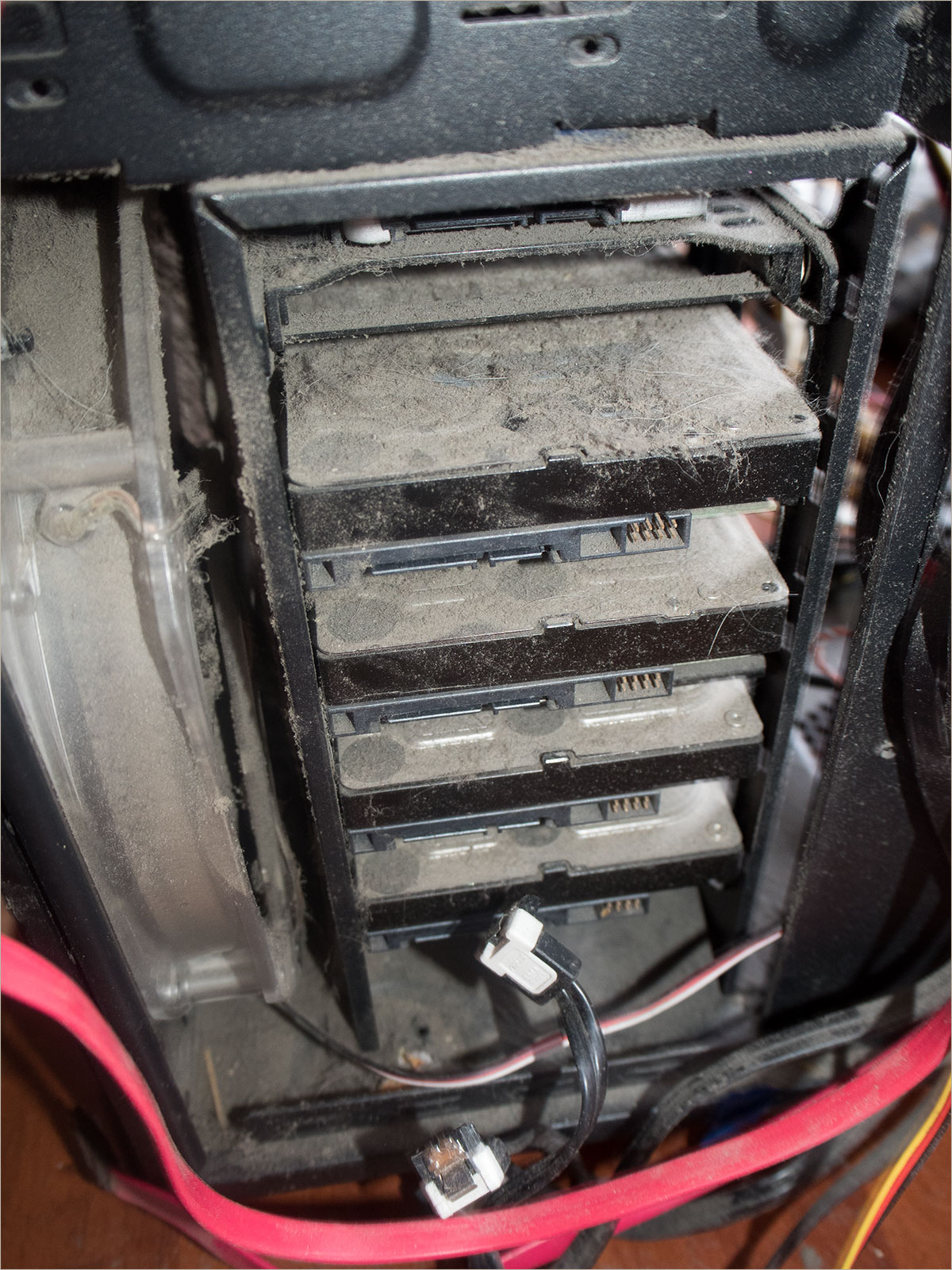
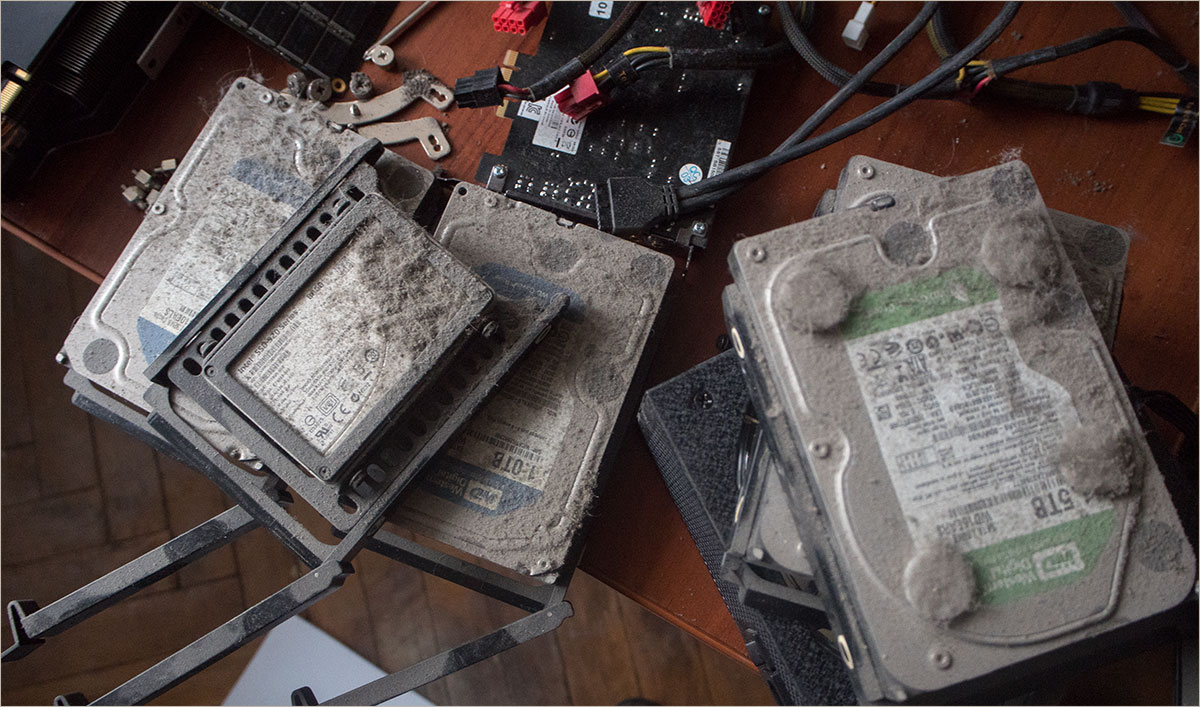
This comrade blew on the screws for about five years, from the moment they were installed in the case until recently:
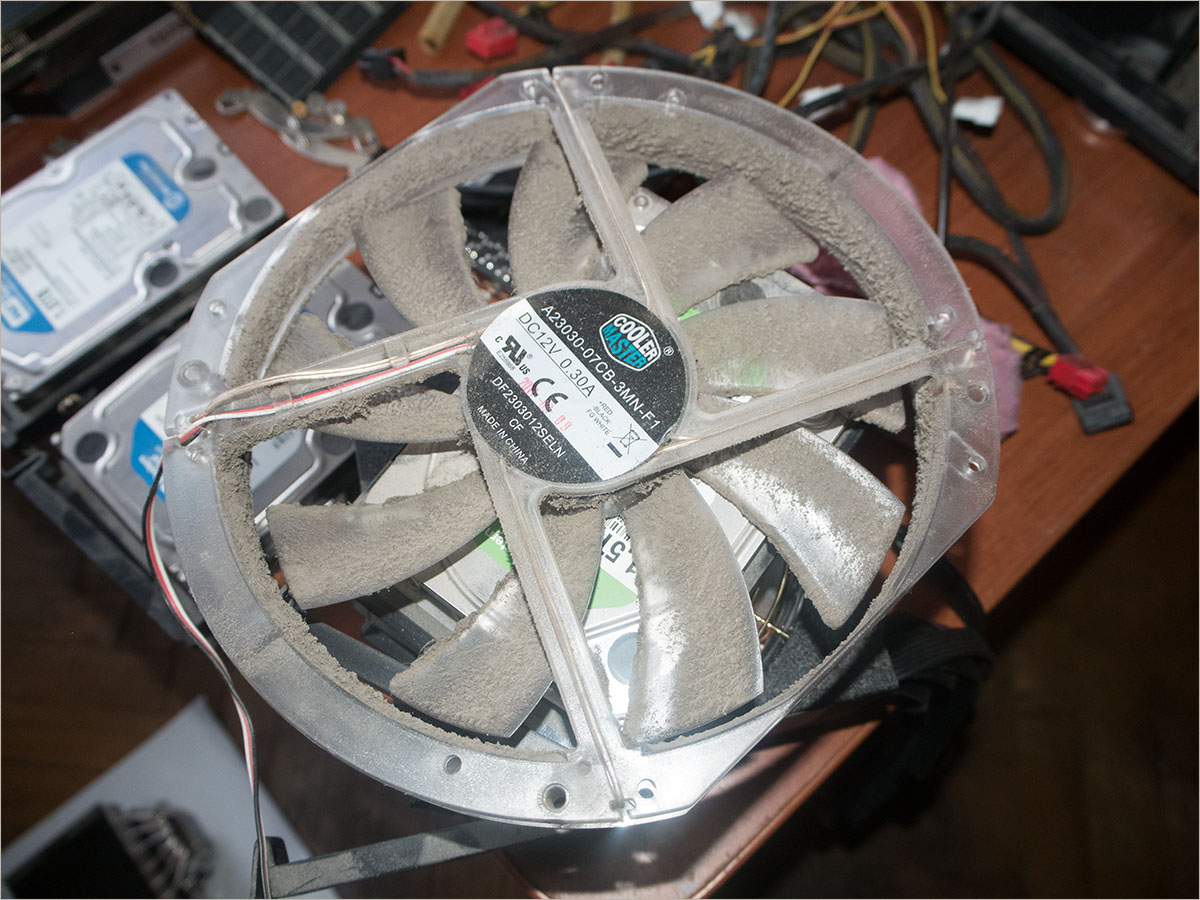


This comrade blew on the screws for about five years, from the moment they were installed in the case until recently:

The processor is simply wiped with a cloth. Everything came literally in 1 second.

He cleaned out all the dust, wiped the case, threw away the garbage, washed the fans, it was time to collect the water cooler. Her instruction, to put it mildly ... Primitive. One such leaf here:

Regular fans have frames from ... I would call it hard grades of rubber. In fact, most likely, this is just flexible plastic, albeit a "rubber" touch. Vibration absorbs perfectly.

In the photo there is a package with mounts for the socket 2011 of the first revision of these dropsy. The mounts are frankly terrible, but along with dropsy I got another set of mounts, completely different in terms of quality and ease of installation. That is, while this CBO was reaching us, the developer managed to fix the marriage and also finish the jamb fix sets for retailers. Nicely.

The weight 2.0 mounts have already been used here:

As you can see, the radiator goes into the basket of optical drives, but this does not interfere with the installation and blowing. The new power supply has flat cables; there is no problem with placing them at the back. The pump itself is powered by a standard fan connector on the motherboard. Some competitors take power from internal connectors for USB connectors.

A trio of fans connects to the system board through such an adapter. To be honest, I'm not very happy with this decision: I'm not sure that the motherboard manufacturers were counting on connecting three loads to one place. Such currents can kill both the connector and the paths leading to it. I would be calmer if only the instructions from the motherboard for the desired speed were taken from this bus, and the power was supplied separately, from USB ports or a SATA / IDE cable.

The white connector, apparently, is designed to install more and power the pump. A strange decision, then I will finalize with a file. ^ _ ^

Everything is assembled and with a backlight. You can close the lid, it’s time for tests. In the BIOS, remove the PWM for the pump, set the SILENT profile for the fans, set the minimum speed to 400. After a few minutes, the system becomes completely silent (which was the case with Noctua NH-D14), only the power supply fan is heard. Bubbles of air from the cooling circuit came out quickly, however, I did not shake actively and did not turn the system over. There were complaints on the network about the noisy operation of the pump, my copy does not suffer from this.

In idle time, after the system temperature has settled down, the picture is somewhat worse than with the NH-D14 tightly clogged. Two hours of heating did not allow the system to warm up higher than 56.5 degrees, that is, under load, the effect is the same as that of the super tower, which collected dust for more than three years.

Here the casing made its corrections to the measurement: the well-blown BigTower with plenty of free space and extremely perforated on all sides.
Even the AIDA-64 stress test failed to warm the processor above the throttling temperature:

With the cooling of even such an "evil" processor as the six-core i7-3930K, the system coped with dignity. At the end of the test, the fan speed rose slightly, but in general the acoustic picture remained more than comfortable. But if the difference with the “super-towers” (and the NH-D14 is by far not the coolest super-cooler) is not so great, why then do we need maintenance-free air-conditioning systems? The answer is simple: for tight cases and tricky assemblies.
Such a “two-section” (Captain 240) allows you to build a very powerful PC based on the top consumer i7 with MiniATX-board in an ultra-compact package (especially if you use the relatively cold GTX 970/980 / 980Ti, which passive or semi-passive cooling most of the time). The only condition is to use high-quality cases, which provide for the normal location of the water cooling system and blowing hot air out of the case - the Corsair Carbide 240 Air or TT Core V21 are perfect. Yes, if desired, something classic can be crammed into them, but here the question of the competent organization of air flows will arise in full growth.
What to choose?
If you are not a fan of overclocking, use conventional processors (from Pentium G3250 to Core i5 / i7 without the “K” index at the end) and don’t want to spend a lot of money on cooling - take the Cooler Master Hyper 212 Evo . Proven solution. Quiet, reliable, widespread, inexpensive and not the largest cooler.
In small-sized cases (well, suddenly you are going in an ITX-format based on i7, which you will not find any perversions today), the Noctua NH-C12P SE14 will be an almost ideal option . Of course, the height and amount of free space should be compared in advance, not all buildings are equally well designed. An alternative for Noctua is the Thermalright AXP200 .
With the K-series of modern i7 and i5 they can even cope with hard overclockingNoctua NH-U12S , NH-U14S , well, and in compact cases factory two-section CBO will come to the rescue.
Super towers and similar three-section monster-CBO are relevant only in the case of a very hot climate or the use of high-end processors, such as the eight-core i7-5960X . Well, or if you misunderstood the AMD 9590 . According to
PS:Look at the computer more often, even if everything is normal according to temperature sensors and the general state of health of the iron. Nothing good from such an amount of dust, as I have accumulated, is definitely not worth the wait.
PPS: We will talk about how well DeepCool Captain 360 handles overclocked SandyBridge-E next year.
